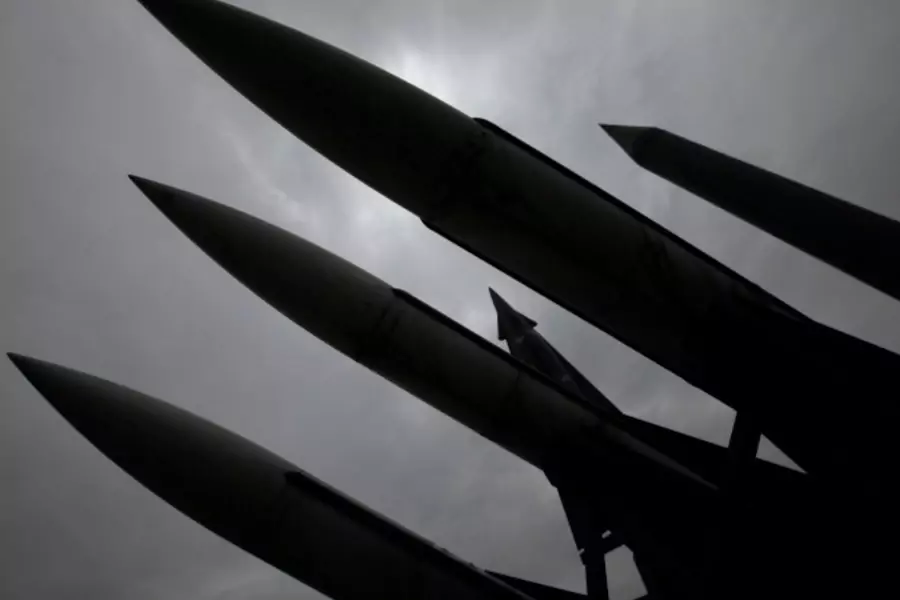Bruce Bechtol: Nukes Aren’t the Only Weapons in North Korea

More on:
Bruce E. Bechtol, Jr., is associate professor of political science at Angelo State University and president of the International Council on Korean Studies. His is the author of North Korea and Regional Security in the Kim Jong-un Era.
During the latter part of February, North Korea conducted test launches of a new long-range 300 mm multiple rocket launcher (MRL) system. These launches from North Korea’s east coast were followed up by still more launches in following weeks. Since then, North Korea has launched Scud missiles from its east coast, 300 mm MRLs, 240 mm MRLs, and Free Rocket Over Ground (FROG) systems. This week, North Korea launched Rodong ballistic missiles. All systems were launched from the east coast, and all tests were conducted even as North Korea appeared to be moving toward a more reasonable attitude toward the United States and its neighbor to the South.
While some would call the launches provocative, like any other nation with a military, North Korea needs to maintain and upgrade its current and new systems. Thus, these systems must be test-launched from time to time. This is particularly applicable to the new 300 mm MRL system that we have observed North Korea testing starting around a year ago.
While ballistic missiles are an important part of the North Korean military arsenal, the MRLs along the DMZ can target Seoul and key nodes in Gyeonggi Province at a moment’s notice. They can simply be pulled out of hardened shelters and caves and used to fire rockets at military bases and civilian population centers within their range, which is why the new 300 mm MRL is so important. If deployed along the DMZ, units using this new system would increase target range to include Osan Air Base and Camp Humphries, as well as key ROK military nodes at Daejeon. The Rodongs test-launched this week were fired from a mobile launcher, and have the range to target Tokyo or U.S. bases in Okinawa.
Pyongyang did not need to conduct these specific tests during large-scale joint ROK-U.S. military exercises that would raise eyebrows throughout the region. These tests were conducted during this time period for a specific reason: to garner attention and demonstrate resolve as their enemies to the South conducted exercises with the United States designed to deter or defend against a Pyongyang-initiated attack. While this is important, I believe the specific message sent by testing Scuds, Rodongs, rockets, and MRLs during this time period was far more focused.
All of these rocket and missile systems that the North Koreans have tested in recent weeks have one important thing in common: they are the weapons that North Korea would use in any initial strike against South Korea and Japan in wartime. This “initial” strike is what most analysts know as the “quick strike,” the initial results of which would be almost impossible to prevent.
MRLs, Scuds, and FROGs are among the systems that the North Korean People’s Army will use to strike Seoul, key military installations south of Seoul, and nodes that will cause panic all over the South. Rodongs would be used to strike Japan, as well as the U.S. bases there. Perhaps in reaction to the recent joint-combined exercises, Pyongyang is showing the ROK and the United States that they maintain—and often upgrade—their “quick-strike” capabilities.
Recently some analysts have made remarks that North Korea’s conventional military capabilities are “rapidly deteriorating.” Some have attributed this to U.S. government reporting, but this type of analysis is in fact misinterpretation of the government reports due to a lack of knowledge regarding terrain-based strategy, military order of battle, disposition of forces, and development and acquisitions by North Korean military forces. In fact, those who believe the North Korean threat is not at least in some ways more, not less, threatening to South Korean and American interests in the region than it was twenty years ago have not conducted detailed research and analysis of the North Korean military and its strategy. Indeed, if one is to make an intelligent assessment of the North Korean threat since Kim Jong-il’s death, not only are capabilities being maintained and in some cases increased, but the power behind these military threats is now more unstable and unpredictable than it has been since the 1950s. This is an important consideration that policy makers, military planners, and academics should keep in mind.
North Korea is a country that presents many military planning dilemmas. While the current instability in the government shows that planning for collapse is a vital element of current planning efforts, that same instability and lack of predictability shows that the possibilities for a military conflict remain an important threat that must be deterred. Though long-range missiles and nuclear programs are important and get most of the attention, Washington and Seoul should never forget that the other threats the North Korean military continues to maintain and improve present a very real threat to the security and stability of the peninsula.
More on:
 Online Store
Online Store